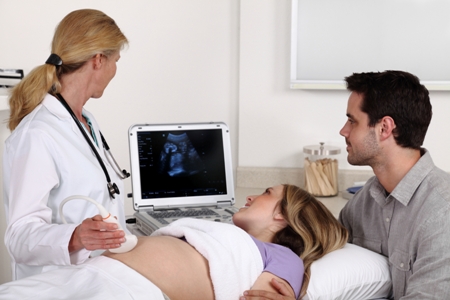
One of the most anxious moments when you are trying to conceive is the confirmation of you being pregnant. Many early signs of pregnancy set in as early as a week after conception. With advancement in technology, there are a number of ways to determine pregnancy. Most of the tests can detect as early as five to seven days after missing the period. Majority of the tests depend on the presence of hCG in the blood and urine of the pregnant woman. The market has various home pregnancy test kits that are quite accurate and easy to use. A test is considered positive if the hCG level goes beyond an ascertained level. Apart from these tests, there are a number of body symptoms that you can experience that can help to detect pregnancy. A prenatal appointment with your doctor is helpful to validate your concerns, fears and to confirm your findings. Following are some ways to determine the pregnancy in its early stages.
Urine test
One of the basic tests to confirm pregnancy is to confirm the presence of Human Chorionic Gonadotropin (HCG). This hormone is released only when a woman is pregnant. It surfaces in the urine and blood of the pregnant woman immediately after conception. The concentration of this hormone is significant in a mother’s urine and makes a good marker to confirm a pregnancy. The sample urine is collected in a sterile cup. Normally, the first urine sample is preferred since it is the most concentrated. When the HCG concentration is equal or greater than 20 mlU/ml, then the test is considered positive. This type of test is about 98 percent accurate. A woman can take up this test after missing a menstrual period.
Blood test
There are two types of blood tests to determine the presence of HCG in the blood. Qualitative and Quantitative blood tests measure the actual level of HCG in the blood. Since the embryo grows very rapidly, the level of HCG also increases significantly every two to three days. These tests involve drawing of the blood from the vein. Qualitative HCG blood test checks for the presence of the hormone while Quantitative pregnancy test helps to measure the specific level of HCG in the blood. It can also determine the precise age of the fetus and can diagnose abnormal pregnancies. The test is considered positive, if the HCG the levels are more than 10 mlU/ml. Any abnormal results may indicate other disorders including, ovarian cancer, miscarriage, ectopic pregnancy or the presence of twins or triplets.
Body symptoms
The body gives out vital signs to determine a pregnancy. There are significant changes in the body during the first month of pregnancy including:
a. Missed periods: If you have been having regular cycle of menstruation, then a missed period is one of the obvious signs of being pregnant. If the date of your period is late for about a week, you are more likely to be pregnant.
b. Morning sickness: The hormonal changes within the body cause unusual morning sickness and can develop at any time of the day. This disturbance is mostly seen during the early hours of the day.
c. Dizziness: The uterus swells and compresses the arteries causing decrease in the blood pressure. This causes dizziness in the early stages of pregnancy.
d. Other symptoms include mood swings, change in taste, brittle nails, pale complexion, breast tenderness, physical exhaustion and frequent urination
Home pregnancy test kits
Modern pregnancy kits are available that helps in the determination of pregnancy in matter of few minutes. These are very easy to use and save the hassle of a blood test. Most of the kits determine pregnancy using the hCG concentration in the urine. The collected sample of urine is placed on a chemical strip. It should be left for couple of minutes before it shows the result. Normally, a home pregnancy test is performed after seven to ten days after missing the menstrual period. The success rate of home pregnancy tests is about 99 percent if all the instructions are followed and carried out properly. This is a very popular type of test carried out by most of the women in the privacy of their home and can be performed during the very early stages of pregnancy.
Ultrasound exam or Sonogram
More information about the embryo or the fetus can be obtained with an ultrasound procedure. However, this is performed only when the pregnancy has advanced at least six weeks. Ultrasound uses waves that scan the abdomen and the pelvic cavity which creates the picture of the placenta and the baby called the Sonogram. Both the terms are used interchangeably and mean the same type of exam. This test involves using gel on the abdomen which works as a conductor to produce sound waves. A transducer creates the sound waves in the uterus to create black and white image of the embryo or fetus. It provides useful information about the fetus including its size and the location. Ultrasound and hCG tests complement each other in terms of providing and interpreting a pregnancy.
Online symptom checker
There are tons of parenting websites that have tools and symptom checkers to help determine the pregnancy. Essential data such as date of last menstrual period, average cycle length and other symptoms such as abdominal cramps, frequent urination etc. are checked off from a list to narrow down the probability of being pregnant. The success rates of such checkers are not too definitive as the other physical tests.
Pelvic exam
Yet another way to confirm pregnancy is by undergoing a pelvic exam. The doctor can determine the size of the fetus, fallopian tubes, ovaries, uterus and the age of the fetus. This exam is normally conducted after six week of conception or the last period. It also helps to detect abnormalities such as an ectopic pregnancy. The doctor will ask for a blood and a urine test along with the pelvic exam before confirming the pregnancy. Pelvic exams results often complement the blood and the urine analysis.


